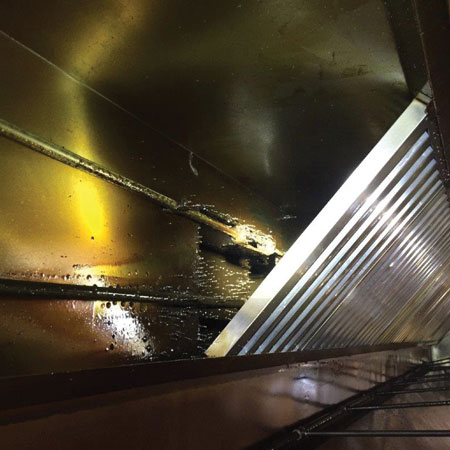
By VINCENT M. KNOTT
Do you consider yourself an aggressive firefighter? If so, are you aggressive in all aspects of the job? Much like in firefighting, those ideals, values, and culture that make you an aggressive firefighter should be applied to every fire inspection you conduct. Time and time again, we bear witness to countless tragedies that could have been prevented (or at least minimized) if there had been “aggressive” and thorough enforcement of the fire code.
 |
| (1) Westampton Township (NJ) Emergency Services’ Truck 27 assisting during an annual fire inspection. (Photos by author.) |
To remain current in fire code enforcement, I have taken countless continuing education courses that have espoused that fire prevention and fire code enforcement are the backbone of a successful fire department. In one of these courses, the instructor started his slide presentation with a list of the names of the last fire inspectors who conducted the fire inspections prior to some of the deadliest fires in history. The names are not listed to point blame; they are meant to serve notice to us that our actions-or lack thereof-greatly impact the outcome of such events and solidify the need for thorough and consistent fire safety inspections.
This article offers guidance and a few tips I picked up along the way in my trials and tribulations as a fire inspector. This is for those of us who hear daily, “Well, the last guy didn’t say that” and “That must be a new requirement.”
Aggressive Tips
Whether you are inspecting a warehouse, a sports venue, a local chain restaurant, a skyscraper, or even a battleship, following are a few tips to help you stay aggressive in your fire inspections.
Review previous inspection reports. Never care about how many violations the previous inspector wrote or even who wrote them; review all of the available previous inspection reports to check for discrepancies, changes of use or condition, alterations to fire protection systems, and missed deficiencies of professional testing/inspecting to ensure that you have as much “intelligence” as possible for the task at hand.
No appointments needed. Unless your agency requires you to make an appointment to conduct the fire inspection, there is no benefit to making an appointment. If you find it necessary, give the business owner one chance to reschedule after you make your first attempt; then, go back at your agency’s convenience. You want to see the business during its normal hours of operation, not after occupants clear all of the potential violations just before your visit. The best chance you have at finding and ultimately correcting these violations is to find them during an unannounced inspection.
Do that 360°. I start every fire inspection the same way: I walk around the structure in a counterclockwise pattern to mentally preplan and prepare, taking notice of the building’s utilities, dimensions, exterior hazards, egress paths, fire department access routes, and fire department connections (FDCs). Doing so builds consistency and allows me to find violations such as incorrect and mislabeled FDCs, unpassable fire lanes, and even an outside explosives detonation area.
Get to the roof. I cannot tell you the number of fire inspectors I have come across in my career who never do this. Just as going to the roof during suppression is a vital task for crews, so is it for your fire inspection (photo 1). Going to the roof has led to the citing of many an imminent hazard such as dangerous grease buildup on the top of a business’s commercial kitchen exhaust system; potentially deadly, large, camouflaged holes in the roof; unsafe structural conditions; and the occasional illegal rooftop drug manufacturing area. For those of you who think a building does not have roof access, always ask yourself, “How can I go to the roof?”
Go interior. Get inside every nook and cranny during a fire inspection. Inspect every room, every closet, every mechanical room, even every restroom, everywhere! Attics, basements, crawl spaces, hidden tunnels (don’t laugh)-get in everywhere to ensure that you don’t miss any potentially dangerous conditions or fire code violations. Are you trying to find improper storage in the attic? You must look. Are you trying to find illegally converted bedrooms in a windowless crawl space? You must look. Are you trying to find a coat closet that keeps an “ugly” kitchen range from view? You must look.
Try before you pry. Open every door, and watch every door close. Whether they are interior or exterior doors, check for ease of access and use, maintenance of hardware, fire rating, and the effectiveness of self-closers. Those doors could not only be the lifeline for the public inside the structure, but they could also be the difference in sustaining interior conditions during a fire.
Look behind and above. Behind the installed filters in a commercial cooking exhaust/fire suppression system and above drop ceiling tiles are two of the most commonly overlooked areas in our business, often having the greatest potential for disaster. Many common commercial cooking kitchen fire suppression systems use fusible links to activate the system. Grease buildup creates a dangerous condition that not only produces combustible vapors but could render the system inoperable. Ask the business owner or agent to move the filters or ceiling tiles so you can inspect them thoroughly. As is the case with many alternative agent suppression systems, a semiannual inspection by a contractor is required. In addition, have the owner maintain a regular cleaning schedule, which helps prevent a dangerous buildup (photo 2). It’s a dirty job, but somebody has to do it.
School’s out! Required monthly fire evacuation drills at facilities in your area, including schools, prepare occupants for that potential emergency. Witnessing these drills (and not just collecting the monthly log) allows you to have intimate knowledge of the entire process. Verifying appropriate routes of travel, time, employee procedures and actions, and responses will give you the upper hand when it may be necessary to alter those plans or procedures. Ensuring that these high-hazard “potential large loss of life”-type occupancies are prepared for an emergency is one of the foundations of effective fire prevention.
Fire extinguisher visibility. Agree or disagree, but fire extinguishers are an ever-present and necessary tool that most structures employ to prevent the spread of fire. The first step is to ensure that they are visible and unobstructed. Whether it is through the use of 2-D signage in cabinets or incorporating their location in those monthly fire drills, verifying that occupants are familiar with fire extinguisher locations, and not just their use, is paramount. Many fire codes require installed fire extinguishers to be maintained annually and inspected by a certified contractor, who would tag the extinguisher as confirmation. On the rear of those tags is a monthly log for the building’s occupants to check and sign off that the fire extinguisher is present, charged, and maintained. This allows for greater participation in fire safety on behalf of the business while simultaneously familiarizing occupants with its location.
Driving around the block. If you remember the television series Firehouse USA, you will remember the late Lieutenant Kevin Kelly of the Boston (MA) Fire Department (BFD). In one episode, Lieutenant Kelly and the crew of BFD Ladder 26 responded to a fire alarm activation in a movie theater where the manager had silenced the fire alarm system and did not fully evacuate the building prior to the crew’s arrival. Whenever I come across a business that manipulates any fire protection system panel or device, I am reminded of that episode, and I take the same approach as Lieutenant Kelly. The system worked as intended. It activated-whether because of smoke, fire, or malfunction. Silencing or manipulating the system not only reduces its effectiveness but also hampers the efforts of suppression personnel on arrival. It is required; it is installed by professionals, it is maintained by professionals, and it should only be evaluated after activation by professionals.
Paperwork. Perhaps the most tedious aspects of conducting fire inspections, paperwork and serving a Notice of Violation are two of the most important parts of the job. Ensure that you are using the correct code citation, the correct procedures as required, your paperwork is in proper order prior to service, and you are serving the violations order in a timely manner. Take the time to go over the location of the violation with the person to whom you are serving the notice, read him the actual code cited for the violation, describe to him the exact remedy your agency requires, and (my personal favorite) explain what led to that code being enacted.
From Tragedy to Knowledge
Use the tragedies that you have witnessed or others have endured to show these occupancies’ real-world dangers and risks. I have shown the graphic video of The Station nightclub fire to so many businesses to get this important message across that I have lost count. Use this time to explain the who, what, where, when, and why of these violations; it might just make sense to them. Thoroughly explain their rights to appeal, extension, or any other required procedures; this will save you from embarrassment should you end up in court over your inspection. Before you obtain a signature confirming service, if required, advise that business owner of the consequences of not abating the violations. This is about compliance-not about making money-but sometimes penalties will hopefully get the point across.
 |
| (2) Grease buildup covering a wet-chemical suppression system fusible link. |
The days of “pencil whipping” in this field are over; they should never have even begun. You must strive to use your passion for helping others and your fellow firefighters (who inspired you to get you into this field) to promote fire prevention by aggressively and consistently enforcing the fire code.
VINCENT M. KNOTT is a 15-plus-year fire service veteran, serving the past eight years as a firefighter/emergency medical technician with the Westampton Township (NJ) Emergency Services (WTES) and as the township’s fire marshal. Prior to joining the WTES, Knott was a fire inspector for the New Jersey Division of Fire Safety. He is certified as a fire inspector, a fire investigator, and a fire official and is assigned to the WTES Bureau of Fire Prevention.
Self-Supporting Inspection Bureau
Equipment to Facilitate the Fire Inspector’s Job
THE BASICS OF FIRE INSPECTIONS
Fire Engineering Archives

